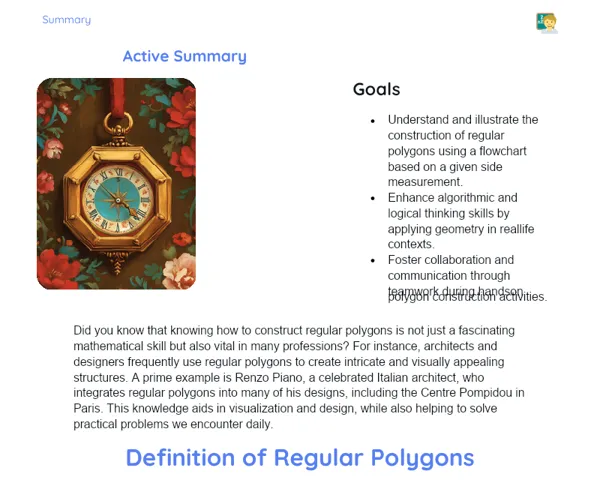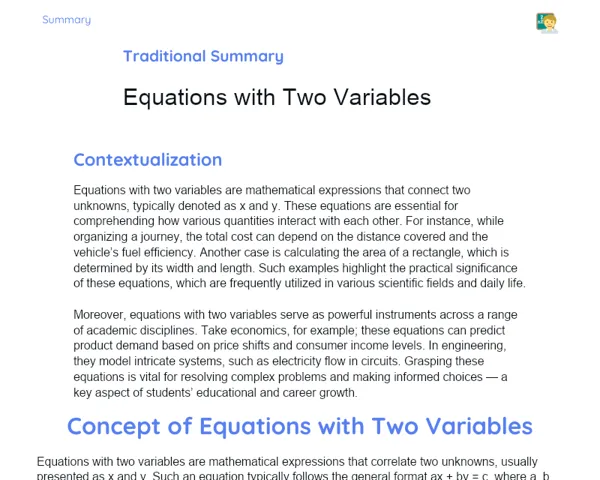Summary Tradisional | Spatial Geometry: Metric Relations of Cones
Contextualization
Spatial Geometry is an important branch of mathematics that deals with the study of three-dimensional shapes, like spheres, cylinders, pyramids, and cones. In our everyday lives, we see these shapes in various objects and structures, making it essential to grasp their properties and applications. The cone is a particular three-dimensional figure with a circular base and a curved surface that narrows down to a single point known as the vertex.
Understanding the metric relations of cones is critical for calculating measurements like height, base radius, and slant height. These metrics have practical implications in fields like architecture, engineering, and design, where measurement precision is very important. For instance, when creating a party hat or designing a speaker, it's crucial to maintain the right proportions of the cone to ensure that the final product is both aesthetically pleasing and functional.
To Remember!
Definition and Elements of a Cone
A cone is a three-dimensional shape with a circular base and a curved surface tapering to a point called the vertex. The base is a circle, and the radius refers to the distance from the centre of the circle to any point on its edge. The height denotes the perpendicular distance from the base to the vertex, while the slant height is the straight line connecting any point on the circumference of the base to the vertex of the cone. These elements are vital for understanding the metric properties of a cone.
When exploring a cone, it's important to understand how these components interact. The circular base serves as the foundation, while the height and slant height contribute to its three-dimensional profile. Notably, the slant height is essential for calculating other properties like lateral area and volume. Grasping these elements is the first step toward tackling problems related to cones in spatial geometry.
Diagrams can be invaluable for visualising the structure of a cone and its elements. Examining a diagram, we can identify the circular base, the height that extends perpendicularly to the base, and the slant height stretching from the vertex to the edge of the base. Such visualization fosters a better understanding of the metric relationships in the cone and aids in applying mathematical formulas correctly.
-
A cone consists of a circular base, a vertex, and a curved surface.
-
The radius is the distance from the centre of the base to the edge.
-
The height represents the perpendicular distance from the base to the vertex.
-
The slant height is the straight line connecting the edge of the base to the vertex.
Relationship Between the Height, Slant Height, and Radius of the Cone
The key metric relationship in a cone can be expressed with the formula g² = h² + r², where g represents the slant height, h is the height, and r is the radius of the base. This relationship is derived from the Pythagorean Theorem applied to the right triangle formed by the height, radius, and slant height of the cone. It allows us to calculate one measurement if the other two are known, which is particularly helpful in solving geometric problems.
For example, if we know the slant height and the radius of a cone, we can find its height by rearranging the formula to h = √(g² - r²). Similarly, if we have the height and radius, we can determine the slant height using g = √(h² + r²). This relationship is fundamental in various practical scenarios, particularly in engineering and architecture where precision in measurements is essential.
Moreover, the metric relationship informs us about how different parts of a cone relate to one another. For instance, a cone with a larger radius and a smaller height will have a greater slant height than one with a smaller radius and height. Such understanding aids in visualising and intuitively solving spatial geometry problems.
-
The essential metric relationship in a cone is g² = h² + r².
-
This formulation arises from the Pythagorean Theorem.
-
It enables the calculation of height, slant height, or radius with the other two measurements.
-
Vital in practical applications that need accuracy in measurements.
Calculating the Height of the Cone
To find the height of a cone when the slant height and radius are known, we employ the formula derived from the Pythagorean Theorem: h = √(g² - r²). This calculation is particularly useful when the height can't be directly measured, but the slant height and radius are accessible. By using this formula, we ensure the calculated height remains mathematically precise, which is critical in many real-world applications.
For instance, consider a cone with a slant height of 10 cm and a radius of 6 cm. Plugging these values into the formula yields h = √(10² - 6²) = √(100 - 36) = √64 = 8 cm. Thus, the height of the cone is 8 cm. This calculation method is straightforward and efficient, allowing for quick problem-solving with accuracy.
The ability to ascertain the height of a cone is crucial across various domains, from engineering to product design. For example, when crafting a conical container, it's important to know the height to determine its volume and capacity. Hence, mastering the height calculation formula is an essential skill for any student of spatial geometry.
-
The formula for calculating height is h = √(g² - r²).
-
This calculation is crucial when height can't be measured directly.
-
Using the formula guarantees mathematical precision.
-
It's fundamental in numerous practical fields, including engineering and design.
Calculating the Length of the Slant Height of the Cone
To calculate the length of the slant height of a cone when the height and radius are known, we employ the formula g = √(h² + r²). This principle, rooted in the Pythagorean Theorem, is vital when determining the slant height where measurements for the height and radius are more accessible. The length of the slant height is an important measurement that defines the cone's curved surface and is applied in various practical contexts.
For example, if we have a cone with a height of 12 cm and a radius of 5 cm, substituting these figures into the formula provides the slant height: g = √(12² + 5²) = √(144 + 25) = √169 = 13 cm. Therefore, the slant height measures 13 cm. This calculation method is efficient and ensures the accuracy of the slant height, which is crucial for creating and designing conical objects.
Calculating the slant height is particularly significant for projects involving curved surfaces, such as producing conical containers or in architectural modeling. Grasping how to apply the slant height calculation formula allows for effective and precise resolution of spatial geometry problems.
-
The slant height calculation formula is g = √(h² + r²).
-
This principle is handy when slant height isn't measured directly.
-
The slant height determines the curved surface of the cone.
-
Crucial for constructing and designing conical objects.
Practical Applications of Metric Relationships in Cones
The metric relationships of cones find diverse applications in fields like architecture, engineering, and design. By comprehending these relationships, one can create projects with accuracy, ensuring that structures and objects possess the right proportions and operate effectively. For instance, ensuring the proportions of height, radius, and slant height while designing a party hat allows it to attain the desired shape.
In engineering, these metric relationships are employed in designing mechanical components like funnels and conical tubes, where measurement precision is paramount for the effective operation of systems. Likewise, in architecture, grasping the metric relationships aids in crafting conical structures like domes and towers with safety and precision. The application of these formulas guarantees adherence to specifications and technical standards.
Furthermore, these metric relationships are crucial when modeling objects within three-dimensional design software. When creating digital models of cones, it’s essential to ensure proportional accuracy for the model to be effective in simulations and analyses. Understanding and applying these relationships enables efficient problem-solving and the development of functional, well-designed projects.
-
Metric relationships of cones are applied in architecture, engineering, and design.
-
They secure precision in project measurements and proportions.
-
Utilized in designing mechanical components and architectural structures.
-
Crucial in modeling objects using three-dimensional design software.
Key Terms
-
Cone: A three-dimensional shape with a circular base and a curved surface converging to a vertex.
-
Radius (r): The distance from the centre of the circular base to its edge.
-
Height (h): The perpendicular distance from the base to the cone's vertex.
-
Slant Height (g): The straight line connecting any point on the circumference of the base to the vertex.
-
Pythagorean Theorem: A fundamental mathematical concept used to compute the height, slant height, or base radius of the cone.
-
Metric Relationships: Formulas that describe the relationships between the height, slant height, and radius of the cone.
Important Conclusions
In this lesson, we delved into the core characteristics of a cone, including its circular base, height, and slant height. We discovered how to compute the height using the slant height and radius, alongside determining the slant height from the height and radius, utilizing the fundamental metric relationship based on the Pythagorean theorem. These calculations hold immense value across various applications in architecture, engineering, and design, where measurement accuracy is vital.
Grasping the metric relationships of cones aids in effectively and accurately solving geometric problems. We discussed real-world applications, such as in the design of party hats, speakers, and conical architectural structures. Mastering the calculations for height, radius, and slant height is a foundational skill that supports the creation of projects with precise proportions and optimal functionality.
It’s essential to continue exploring and deepening our understanding of spatial geometry, given its extensive applications across multiple fields of knowledge and professional practices. I encourage you to engage in more exercises and apply these formulas in varying contexts to bolster your skill and comprehension in geometry.
Study Tips
-
Revisit the practical examples discussed in class and attempt to solve similar problems independently to reinforce your understanding of the metric relationships of cones.
-
Utilize diagrams and visual aids to help conceptualise the relationships among the height, slant height, and radius, aiding the application of the formulas.
-
Seek additional resources, such as explanatory videos and online exercises, to broaden your knowledge and practice further calculations involving cones and other three-dimensional shapes.



